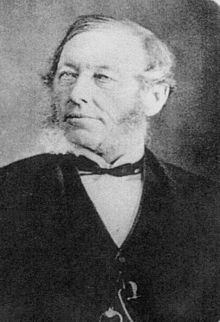
Back إدموند شارب Arabic ادموند شارب (مهندس) ARZ Edmund Sharpe Spanish ادموند شارپ Persian Edmund Sharpe French Edmund Sharpe Malagasy ايډمونډ شارپ Pashto/Pushto Edmund Sharpe Portuguese Edmund Sharpe Swedish
Edmund Sharpe | |
|---|---|
 Sharpe, c. 1860 | |
| Born | 31 October 1809 Knutsford, Cheshire, England |
| Died | 8 May 1877 (aged 67) |
| Occupations |
|
Edmund Sharpe (31 October 1809 – 8 May 1877) was an English architect, architectural historian, railway engineer, and sanitary reformer. Born in Knutsford, Cheshire, he was educated first by his parents and then at schools locally and in Runcorn, Greenwich and Sedbergh. Following his graduation from Cambridge University he was awarded a travelling scholarship, enabling him to study architecture in Germany and southern France. In 1835 he established an architectural practice in Lancaster, initially working on his own. In 1845 he entered into partnership with Edward Paley, one of his pupils. Sharpe's main focus was on churches, and he was a pioneer in the use of terracotta as a structural material in church building, designing what were known as "pot" churches, the first of which was St Stephen and All Martyrs' Church, Lever Bridge.
He also designed secular buildings, including residential buildings and schools, and worked on the development of railways in north-west England, designing bridges and planning new lines. In 1851 he resigned from his architectural practice, and in 1856 he moved from Lancaster, spending the remainder of his career mainly as a railway engineer, first in North Wales, then in Switzerland and southern France. Sharpe returned to England in 1866 to live in Scotforth near Lancaster, where he designed a final church near to his home.
While working in his architectural practice, Sharpe was involved in Lancaster's civic affairs. He was an elected town councillor and served as mayor in 1848–49. Concerned about the town's poor water supply and sanitation, he championed the construction of new sewers and a waterworks. He was a talented musician, and took part in the artistic, literary, and scientific activities in the town. Also an accomplished sportsman, he took an active interest in archery, rowing and cricket.
Sharpe achieved national recognition as an architectural historian. He published books of detailed architectural drawings, wrote a number of articles on architecture, devised a scheme for the classification of English Gothic architectural styles, and in 1875 was awarded the Royal Gold Medal of the Royal Institute of British Architects. He was critical of much of the restoration of medieval churches that had become a major occupation of contemporary architects. Towards the end of his career Sharpe organised expeditions to study and draw buildings in England and France. While on such an expedition to Italy in 1877, he was taken ill and died. His body was taken to Lancaster, where he was buried. Sharpe's legacy consists of about 40 extant churches; railway features, including the Conwy Valley Line and bridges on what is now the Lancashire section of the West Coast Main Line; and his archive of architectural books, articles and drawings.